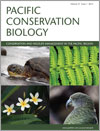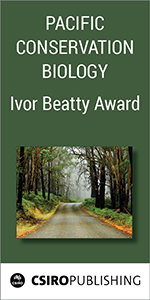
Pacific Conservation Biology
Volume 21 Number 1 2015
The Editor-in-Chief gives an overview of changes and outlines plans for Pacific Conservation Biology for 2015 and beyond.
As a people, Australians have lost contact with nature, while science has failed to protect Australia's flora and fauna. Science needs to assume leadership in nature conservation, but saving nature will not be easy as it requires a reduction in the consumption of resources and a smaller population.
PC14901Cold-blooded indifference: a case study of the worsening status of threatened reptiles from Victoria, Australia
Reptiles fare poorly in terms of conservation attention and funding, due in part to their unpopularity compared to other terrestrial vertebrates. This paper documents worsening trends in the status of reptiles in Victoria, examines key threats to this fauna, and considers the steps needed to conserve Victorian reptiles.
PC14902Distribution, population structure, and management of a rare sandalwood (Santalum yasi, Santalaceae) in Fiji and Tonga
The culturally and economically valued sandalwood of Fiji and Tonga has faced cyclical harvesting and fluctuating distribution and abundance from the early 19th century to the present. Sparse and scattered distribution and discontinuous size–class structure reveal waning wild populations, while economic and sociocultural challenges complicate management practices.
PC14903Bárcena Volcano, 1952: a 60-year report on the repopulation of San Benedicto Island, Mexico, with a review of the ecological impacts of disastrous events
Only a few times in human history have scientists had the opportunity to study a volcanic eruption, its impact, and the following repopulation and revegetation. In August of 1952 a volcano erupted on San Benedicto Island, Mexico and killed approximately 20 000 sea birds in a few minutes. This study reports on 60 years of post-volcanic research on sea birds, land crabs and plants. The responses of these organisms was variable and not easily predictable.
PC14904Determinants of bird assemblage composition in riparian vegetation on sugarcane farms in the Queensland Wet Tropics
Remnant riparian (stream-side) vegetation among sugarcane fields has high conservation value as it supports diverse assemblages of forest and generalist bird species. Assemblage composition is determined by riparian width and distance from source forest, but forest specialists require native riparian vegetation to be at least 90 metres wide.
PC14905Effects of environmental variation on the composition and dynamics of an arid-adapted Australian bird community
Over four years, pronounced changes in the abundance and composition of an Australian arid-adapted bird community were documented. Changes were related to drought, season and local habitat heterogeneity. Overall bird abundance and species richness declined during drought but responses of different bird movement and feeding groups and individual species to environmental variability were not consistent.
PC14906Enhancing legal frameworks for biodiversity conservation in the Pacific
This article examines community-based marine management in the Pacific through a legal lens. It outlines traditional rules for marine management before exploring the contemporary legal position with a focus on the hybridisation of state-based legislation and customary law. Finally, comments are made on the effectiveness of these legal approaches, as well as remaining challenges.



